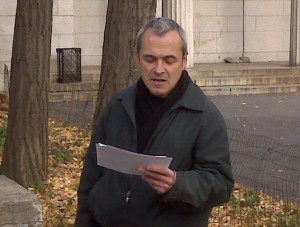Where I found Whitman
I posted my Whitman reading a few days ago to the map portion but didn’t include it on my blog.
This reading was done in Whitman park in Brooklyn.
I posted my Whitman reading a few days ago to the map portion but didn’t include it on my blog.
This reading was done in Whitman park in Brooklyn.
Fort Greene
History is all around us, especially in Whitman’s Brooklyn. I am aware that New York City has many historical landmarks but I didn’t realize the significance of Fort Greene and how Whitman helped create it.
The class met at the park, along the way I saw Walt Whitman projects across the street. We met in the spot below near the small building:
We where greeted by people from the Whitman Project.
The CUNY Walt Whitman class had the pleasure and privilege to be guided by artistic director Greg Trupiano. He gave us some background
We first spoke about Leaves of Grass. The artistic director (Greg Trupiano) pointed out some physical qualities of the first book and an image of Whitman. Most people in the 19th century, especially writers like Emerson dressed in a very professional manner. Whitman instead is dressed in a working man’s clothes. He looks like a regular blue collar worker in his book of poems. This is more significant then I thought and one of the reasons that Whitman is seen as the people’s poet.

Blue Collar Whitman
Mr. Black who is another person affiliated with the Whitman project read a poem from Whitman’s Collection. I didn’t get a chance to record his passionate reading but I think one of my classmates capture it with a flipcam.

The next discussion was about setting type. The image below is a keep sake that Greg Trupiano gave the class from his own private collection.


We then dicussed the reasons why Whitman pushed for the creation of Fort Greene. To summarize:
1. He felt the Wallabout Martyrs deserved a proper monument.
2. He used his influence as the editor of the Daily Eagle to persuade people to support his cause.
3. He lived in the area and thought that people should have a park to enjoy.
Fun Anecdote # 1
I learned about how the terms uppercase and lowercase came about. Uppercase or capital characters are higher and harder to reach then lowercase when people use to set type; makes sense.
Fun Anecdote #2
“Having a copyright doesn’t mean you wrote the book.”
Fun Anecdote #3
Leaves of Grass was banned in Boston in the early 1880s which added to the book’s controversy. Subsequently, the 1880 copy was the best selling edition of Leaves of Grass.
We made our way torward The Tombs which you can see in the video below.
The Tomb is really an incredible piece of history. Some of the old bones from the old memorial wihch just fell apart over time.
Best picture I took in my life… ever
Our tour concluded with a walk around the Brooklyn neighborhood and a look at 99 Ryerson street. It’s the last piece of history in New York that Whitman lived in that is still standing today. Students from Pratt currently inhabit the building.

Resources: These are additional links to learn more about Walt Whitman and the park
[1] This is the website of Greg Trupiano about Whitman http://www.whitmanproject.org/
[2]Wikipedia is a decent place to start when looking for leads and additional information regarding a topic. It is by no means authoritative. http://en.wikipedia.org/wiki/Fort_Greene
[3] Fort Greene Park Conservancy http://www.fortgreenepark.org/pages/contents.htm
[4] This website provides a historic context of the park: http://www.historicfortgreene.org/
Franklin Evans Part II
After reading my first post on Franklin Evans, I think I alluded to some important details. Franklins Evans was a novel written by Walt Whitman before he released his celebrated poems, Leaves of Grass. A Google search of Franklin Evans yields almost no content related to Whitman while Song of Myself is a Whitman trademark. Professor Gold stated that most people still don’t know that Walt Whitman wrote Franklin Evans. Whitman even denied writing Franklin Evans at one point but this was proven false. That is one of the reasons the novel is over looked.
Franklin Evans is a novel about intemperance or alcoholism as we call it today. Intemperance has always been a problem in society and it’s vividly described by Whitman as one of the worst evils man can commit. Through the narration of the protagonist Franklin Evans, Whitman shows us the dark side of drinking. The progression of Alcoholism starts destroying Franklin’s life and affecting his loved ones. Evans loses jobs, destroys his marriages and goes to jail as a result of his brandy escapades.
From the offset of the novel, Franklin is always observing the affects of alcohol on people’s lives. His first description of drunkeness was speaking of a farmer who had gone astray due to drinking. Franklin Evans was not drinking at this point, and then he met Colby and that was soon to change. When Colby asks Franklin to join him for a drink, he obliges and goes along with it. He regrets this action and thing come full circle at the end of the story.
I can trace the outset of all frailties, as well all the calamities that have befallen me in life, to that fatal night when Colby drew me into the drinking place; where, amid music and gayety, the first step in my downward road was taken.
Franklin makes drinking seem as an almost inescapable force to that drags down young men in Cities. Many in the novel have fallen prey. This novel is an attempt to encapsulate the many misfortunes a man can meet when he drinks. Franklin Evans stroke of luck saves him, only to sucumb to drinking again. In the conclusion, Whitman calls this novel an experiment. It is not only a look at drinking but a short treatise on temptation in the 19th century. Many temperance groups appeared during the 19th century that discouraged drinking and other vices. This novel is arguably influential and is one of the first pieces of fictional literature that could have been called the Washingtonian Manifesto.